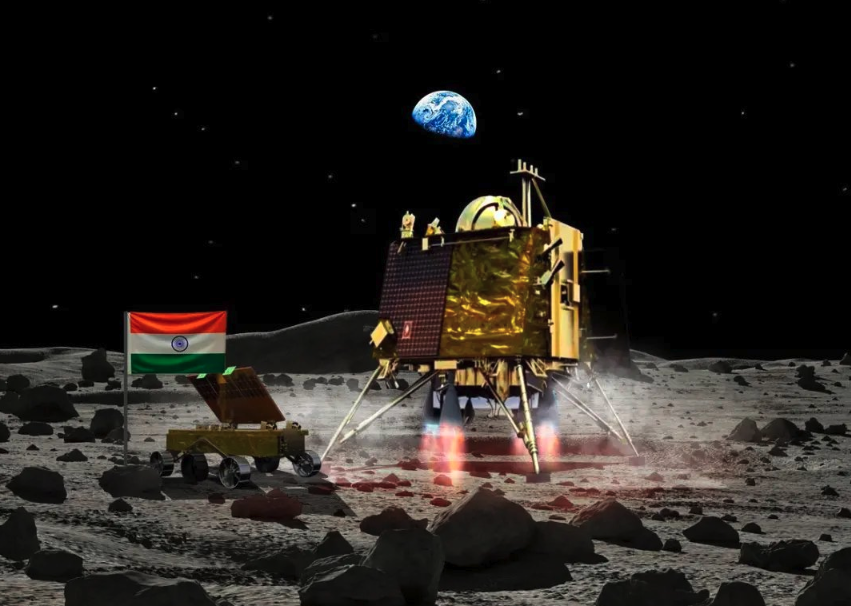From the crash of the Russian Luna-25 to the moon landing of India, how the space race has changed

If Russia failed with its first mission to the moon in almost 50 years, India managed to land on the lunar south pole. Here's how money is shaping the new space race
On August 23, India joined the club of countries that managed to carry out a controlled landing on the moon, consisting of Russia, the United States and China.
A historic moment for the world's most populous country : the Chandrayaan-3 mission landed near the little-explored lunar south pole, a world first for a space program.
For one country that celebrates, another has to deal with failure: India's success comes in fact a few days after the accident of Luna-25, the first probe launched by Russia on the Moon since 1976 in the race to reach the same area of the our satellite before the Indian competitor, which crashed on the lunar surface.
“The seemingly sudden competition to reach a previously unexplored region of the Moon is reminiscent of the space race of the 1960s, when the United States and the Soviet Union clashed, recalls Reuters .
But now space is a business, and the Moon's south pole is a target because of the water ice that experts expect could support a future lunar colony, mining operations and eventual missions to Mars.
As the International Space Station comes to an end, the center of power in space is shifting to the lunar surface.
Whoever "gets to the moon and 'controls' the moon will have a huge advantage in terms of political, economic and military power and this will propel them to dominate the next century," notes Brian Weeden of the Secure World Foundation to Axios .
All the details.
INDIA'S SUCCESS ON THE MOON
With the Chandrayaan-3 mission soft landing, analysts expect India's space sector to benefit from a reputation for cost-competitive engineering.
For India it is the third lunar mission after the 2008-2009 Chandrayaan-1, which ended ahead of schedule, and the 2019 Chandrayaan-2, which ended after the loss of contact with the lander.
In 2020, ISRO estimated that the Chandrayaan-3 mission would cost about $75 million. This week, India also became the first country to land in the southern polar region of the Moon.
IMPULSE TO THE INDIAN SPACE PROGRAM
Under Prime Minister Narendra Modi's urging, India has privatized space launches and is seeking to open up the sector to foreign investment with the aim of increasing its share of the global launch market five-fold within the next decade.
THE PROJECTS NASA
NASA, by comparison, is on track to spend about $93 billion on its Artemis lunar program through 2025, the US space agency's inspector general has estimated.
"Moon landing is difficult , as we're seeing," said Bethany Ehlmann, a professor at the California Institute of Technology, who is working with NASA on a 2024 mission to map the lunar south pole and its ice. waterfall.
WHAT WILL RUSSIA DO?
The Luna-25 accident raises questions about the future of Russia's space program, especially at a time when the country is engaged in a tiring and costly war in Ukraine.
Despite Western sanctions over the war in Ukraine and growing isolation, Moscow managed to launch a mission to the moon anyway, but was unable to land on lunar soil. In fact, some experts currently doubt its ability to finance a successor to Luna-25. Russia has not disclosed how much it has spent on the mission, Reuters said.
“Expenditure on space exploration is being systematically reduced every year,” said Vadim Lukashevich, an independent space expert and author based in Moscow. Russia's budget priority for the war in Ukraine makes a repeat of the Luna-25 "extremely unlikely," he added.
WHAT ABOUT CHINA?
Like NASA, China also aims to send people to the same region of our satellite in the coming years to establish a human presence on the lunar surface.
Beijing made the first soft landing on the far side of the Moon in 2019 and has more missions planned. Space research firm Euroconsult estimates that China spent $12 billion on its space program in 2022.
PRIVATE PLAYERS AIM FOR THE MOON
While the economic benefits may not be guaranteed, a new industry is already being built around the Moon in space, giving more credence to nations targeting the lunar surface, Axios argues.
Private companies are investing in the technology to deliver payloads to the Moon with the hope that once they get there, countries will act as their customers when they establish a human presence on the Moon.
By opening up to private money, NASA has provided the blueprint India is following, local officials said.
Elon Musk's SpaceX, for example, is developing the Starship rocket for its satellite launch business and to carry NASA astronauts to the lunar surface in a $3 billion contract.
In addition to this contract, SpaceX will spend about $2 billion on Starship this year, Musk said.
US space firms Astrobotic and Intuitive Machines are building lunar landers that are expected to launch towards the Moon's south pole later this year, or in 2024. And companies like Axiom Space and Jeff Bezos' Blue Origin are developing successors to the Space Station Privately funded international.
This is a machine translation from Italian language of a post published on Start Magazine at the URL https://www.startmag.it/innovazione/dallo-schianto-della-russa-luna-25-allallunaggio-dellindia-come-e-cambiata-la-corsa-spaziale/ on Sun, 27 Aug 2023 08:12:03 +0000.
